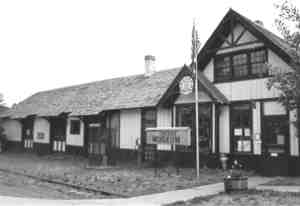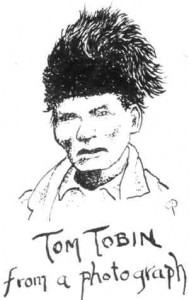Column by John Mattingly
History – November 2008 – Colorado Central Magazine
In mid-September, the west side of downtown Creede was a jumble of railroad ties sticking up from gravel and dirt like randomly dropped pickup-sticks, the rail irons stacked off to the side.
It was a curious sight. At a time when rail transport offers significant economy for moving both people and cargo, why would anyone be tearing out a spur that led into the heart of downtown Creede?
For starters, the old Denver and Rio Grande Western right-of-way under the final mile of the Creede Branch, from MP 319.9 to 320.88, was officially transferred to the city of Creede through an adverse abandonment action, effective June 22, 2008. A victory/appreciation dinner for Washington, D.C., attorney Ronald Johnson, Esq. who handled the case for the City of Creede pro bono was held at the Creede community center in August. In September, several news stories appeared in local papers either extolling or lamenting the abandonment decision. Meanwhile Donald Shank, president of the Denver and Rio Grande Railroad Historical Foundation (DRGRHF), who has been trying to bring a train to Creede for about ten years, began salvaging the rail irons and ties of the abandoned spur.

“It’s a shame, said Robert Wardell,” Creede gentry and former Mineral County judge. “We should have gotten together and stopped the adverse abandonment action. It was one of those things where nobody thought the city and it proponents had a chance, so nobody got excited enough to do anything about it. We’re going to miss having that rail in here, especially if the mines come back.”
On the other hand, “This was decided years ago,” said Martha Owens, president of the Creede Chamber of Commerce. “There was a ballot initiative, I believe it was six years back, and the city defeated Shank’s offer to bring the railroad into town. We didn’t want it. The train would be too close to the existing buildings and bring a lot of traffic we frankly didn’t need.”
But Don Shank and DRGRHF were of the opinion that the railroad right-of-way was granted by federal authority, and thus superseded the local initiative, so Shank moved forward with plans to bring the train to Creede. According to long-time Creede miner and businessman Tom Walters, Shank showed up in town on a Saturday. “I was here with a pickup load of guys, guys who looked like thugs, and they began putting up flags and stakes and telling people to get off the right-of-way or be charged with trespassing. Being as Creede is a town with a fair number of hard-headed hard rock miners, Shank asked for a fight, and he got one.”
A core of Creede business owners, allied with the city council, took the position that the city needed to get control of the right-of-way land within Creede city limits. Reason: a number of businesses on Main Street had constructed backbuildings that extended over the railroad right-of-way, which hadn’t been used since the late 1930s, but Shank now demanded lease payments from the encroaching businesses. Some encroaching entities, such as the Masons, the local bank, and others were already paying a lease, and had been to the previous owners of the right-of way, the Union Pacific. But other business owners and entities determined they might have a case for refusing lease payments to Shank’s Foundation based on the legal theory of adverse possession.
In Colorado, adverse possession requires notorious occupation of the property for 17 years, and it helps if the party seeking adverse possession has paid the taxes on the subject property. The backbuildings in question had notorious occupation of the right-of-way for well over 17 years, but railroad easements are governed by a special set of statutes, regulations, and case law, so it became, in the words of many Creede residents, a can of worms.
It so happened Ron Johnson, a part-time resident of Creede and a D.C. attorney whose specialty included railroad abandonment cases, heard about the matter and donated many hours to advancing, and winning, the city’s argument. The folks who thought the city had little or no chance to unspool the complexities of the case underestimated the city’s chances for success when armed with the services of a specialist. Indeed, Mr. Johnson knew how to build and argue the case, and after eight years of litigation, the City of Creede emerged with a favorable ruling from the federal Surface Transportation Board.
Don Shank said the Foundation could no longer afford to continue pleading its position, and in final regrets, he pointed out that the railroad had much to do with building the town of Creede during its mining boom, and lamented that, “The biggest loss will be to history.”
Shank may have suffered a bit from preservationist’s conceit, presuming the rest of the world shared his evergreen enthusiasm for historical railroads. Creede business owners, however, were less interested in history than in the specter of paying back rent on the railroad property now occupied by their backbuildings. There was a perception, accurate or not, that Shank intended to fund some of the expensive renovation of the track between Creede and South Fork with lease income from the encroaching buildings.
In most cases, the individuals who built the encroaching structures were long gone and the new owners were stuck with a potentially expensive surprise. Struggling to survive in small businesses with significant seasonal fluctuations, the Creede business owners became predictable champions of property rights instead of history, relying on the theory of adverse possession, or in this case, its variant with railroad property: adverse abandonment.
As one business owner put it, “Property rights are as much a part of history as railroads.”
In the American West, Historic Districts are usually 100 to 150 years old, which, by European standards is scarcely more seasoned than yesterday’s newspaper. The U.S. is a relatively young country, the West even younger, and though railroads played a determining role in the development of the West, most Westerners are focused on the future, not the past. Instead of the old adage, “Those who fail to learn from history are condemned to repeat it,” in the West, the prevailing perception is more like: “Those who fail to look to the future are condemned to miss it.”
The Creede business owners, waving the flag of property rights, had allies with other business owners who pointed to the particulars of noise, crowds, and bloated expectations from a railroad drop in downtown Creede. “They (Shank and the D&RGRHF) thought they were doing us a big favor by dropping off a few hundred people downtown during the summer,” said Jenny Inge, a Creede business owner since 1974 (her business was not touched by the encroachment issue). “We’re already over-crowded during that time, and most of the people on a scenic stopover aren’t going to be buying big ticket items or going to the theater. They’ll buy a hot dog and a T-shirt. Maybe. What Shank was giving us was a mess: a lot of trash and congestion, more negative impact than benefit.”
The anti-train coalition carried weight with the City Council and the fortuitous availability of attorney Ron Johnson made the adverse abandonment happen. The prospect of working something out between the parties never got anywhere, as the business owners and preservationists manifest a congenital aversion to compromise.
If it had been anyone but Donald Shank, there might be a train coming to town, noted Christine Funk, Creede business owner since the late ’90s. “Now there’s no chance of working with the city. None. Besides, the tourist ride between South Fork and Creede isn’t that great. Everything you can see from the train you can see from the highway. It isn’t like the great off-road incredible scenery of Cumbres & Toltec.”
So, now, with $4 gas, a pending recession of unknowable depth, frosty credit, and other assorted crises, some folks in Creede are wondering what it would be like to have a weekly freight and passenger train between Creede and Denver. The adverse abandonment decision did not amputate the entire line into Creede, only the final trunk extending into the heart of downtown. A station at the south of town could be put into service not as a tourist attraction, but as a means of economical transport.
Two obstacles face such an endeavor: first, the cost of renovating the rails and bridges and putting serviceable, high-speed units into action, and second, the cultural convenience of automobiles. The first is a business issue that can be projected on a spreadsheet — though it is unlikely a profitable commuter/cargo train could run on the rails between Denver and Creede, stopping in all the cities and towns in between. The bridges are in poor condition, and the current units on the tracks move at such a slow speed that one can travel between the towns and cities faster on a bicycle.
There was some legitimacy to those in Creede who claimed the tourist train ride was more gimmick than substance. Even the popular tourist routes of Cumbres & Toltec and the Georgetown Loop require subsidies beyond the revenues collected from fares. To put in a real commuter/cargo train system would cost big bucks, like what we spend every week in Iraq.
The second issue, automobile convenience, is even more daunting. Anyone who has tried to carpool knows we in the West have become chronically self-centered when it comes to transportation. We like to get in our individual carriers when we want to. Our brains aren’t dialed in to train schedules like those on the East Coast. One of the repeated outcries during the recent bailout debate in Congress was the dire necessity of thawing credit markets so people could buy cars. Excuse my soapbox here, but borrowing money to buy a car is the epitome of financial foolishness, as is borrowing money to purchase any depreciating item. Going back 30 years or so, the bank was the place you saved money to buy a car, not the place you got the money.
That the big bailout of recent weeks didn’t include the outcry “We need to free up credit markets so thoughtful people can capitalize public transportation!” indicates that as much as we might need to repeat the history of train transport in the West, we are condemned to miss it.
John Mattingly is attempting to retire from agriculture in Creede, where damn little grows, especially at this time of year.


